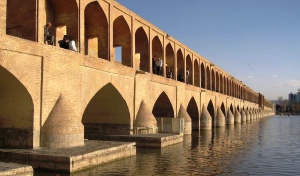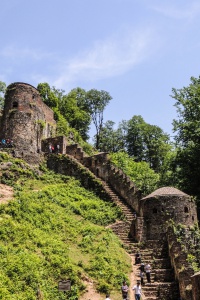Iran's natural stone has a rich history, spanning thousands of years
Throughout history, Iran has used local marbles and limestone in structures like the ceremonial capital Persepolis during the Persian Empire.
During the 7th century Islamic influence, natural stone remained crucial in Iranian architecture, featuring in mosques and palaces with intricate designs, often using various stones like marble.
In the Safavid Golden Age (1501–1736), Persian art and architecture reached a pinnacle, utilizing colorful stones like turquoise and onyx alongside tiles for structures like the Shah Mosque in Isfahan.
In the Qajar Period (1796–1925) following the Safavids, natural stone continued to be used in construction, with elaborate stone carvings and facades in palaces and mosques.
In the modern era, Iran, a major exporter of natural stone, particularly marble, travertine, onyx, and granite, contributes to the global construction and design industries with high-quality, aesthetically appealing stones.
Economically, Iran’s extraction, processing, and export of natural stones are crucial, providing jobs and contributing to both domestic and international trade.
In summary, Iran’s natural stone has been vital throughout history, contributing to its cultural heritage and economic prosperity, from ancient times to the modern era.
Naqsh-e Rustam
Naqsh-e Rustam, located 12 kilometers northwest of Persepolis in Iran, is an ancient cemetery with rock-cut tombs and reliefs from the Achaemenid Empire. The site features notable tombs of Persian kings and reserves depicting imperial scenes, all carved from a soft, fine-grained limestone readily available.
The carvings showcase detailed scenes, including inaugurations, battles, and religious iconography, accompanied by inscriptions in Old Persian cuneiform, Elamite, and Akkadian languages. The deliberate choice of the durable stone and location reflects a strategic decision to ensure the long-lasting commemoration of the Achaemenid kings and their achievements.
Today, Naqsh-e Rustam stands as a testament to ancient Persian civilization’s artistic and architectural excellence.
Si-o-se-Pol bridge

Si-o-Se Pol, also known as the Allahverdi Khan Bridge, is a historic bridge located in Isfahan, Iran. The bridge was constructed during the Safavid dynasty in the early 17th century and is one of the eleven bridges over the Zayanderud River in Isfahan. It is a prime example of Persian bridge design and is renowned for its aesthetic and architectural significance.
The construction material used in Si-o-Se Pol combines stone and brick. The bridge’s primary structure and arches are built using a stone known as Khoy limestone. Khoy is a city in northwestern Iran that has been a source of high-quality limestone for various construction projects.
Khoy limestone is a durable and weather-resistant material, making it suitable for use in bridges and other architectural structures. The stone has a characteristic cream or beige color and is known for its fine grain, allowing for intricate carving and detailing.
The arches of Si-o-Se Pol are particularly noteworthy. The bridge consists of 33 arches, and the name “Si-o-Se Pol” translates to “Thirty-Three Bridges,” referring to the total number of arches. The arches are constructed with a combination of brick and Khoy limestone, creating a visually striking and harmonious design.
The use of stone in Si-o-Se Pol not only adds to its structural integrity but also contributes to the bridge’s aesthetic appeal. The Khoy limestone’s warm tones, the architectural details, and the surrounding scenery make Si-o-Se Pol a popular destination for locals and tourists.
As with many historic structures in Iran, Si-o-Se Pol reflects the region’s rich architectural heritage and the skilled craftsmanship of its builders. The choice of materials, including Khoy limestone, has played a crucial role in ensuring this historic bridge’s longevity and enduring beauty.
Rudkhan Castle
Rudkhan Castle, also known as Qaleh Rudkhan, is a medieval fortress located in the Gilan Province of northern Iran. The castle is situated on the forested slopes of the Alborz mountain range and overlooks the Rudkhan River. It is a popular historical and tourist attraction due to its picturesque location and well-preserved architecture.
The construction of Rudkhan Castle dates back to the Sassanian era (224–651 CE), although it underwent renovations and expansions during the Seljuk and Ilkhanid periods. The primary building material used in the construction of Rudkhan Castle is local limestone.
The limestone used in Rudkhan Castle is likely sourced from the surrounding mountains. This type of stone was chosen for its availability in the region and suitability for building durable structures. Limestone is a sedimentary rock that is relatively easy to quarry and carve, making it a practical choice for historical constructions.
The castle is an impressive structure with immense walls, towers, and gates. The use of local limestone provided the necessary structural strength and allowed for the intricate detailing seen in the architecture of Rudkhan Castle. The stones were cut and arranged to form the walls and towers, and the construction techniques employed highlight the craftsmanship of the builders.

Natural stone
Persisco
Azadi Tower
The Azadi Tower, also known as the Freedom Tower, is an iconic monument in Tehran, Iran. It was built in 1971 to commemorate the 2,500th anniversary of the Persian Empire and is a symbol of modern Iran. The tower is located at Azadi Square and is a prominent feature of the city’s skyline.
The Azadi Tower was designed by architect Hossein Amanat and is a fusion of modern and Sassanian architectural styles. The building materials used in the construction of the Azadi Tower include a type of white marble known as “Gohareh Sangesar.” This marble is quarried from the Sangesar region in Iran.
Gohareh Sangesar marble is a high-quality, crystalline, white marble with a fine texture. It is valued for its aesthetic appeal and has been used in various architectural and artistic projects throughout Iran. The choice of this particular marble for the Azadi Tower contributes to the monument’s elegant and modern appearance.
The tower stands about 45 meters tall and has a distinctive design featuring a large central core with “wings” extending outward. The central core is clad in the white marble, creating a striking contrast with the blue tiles that cover the other parts of the tower. The design is symbolic, with the central core representing unity and the wings symbolizing progress and freedom. The use of Gohareh Sangesar marble in its construction adds to the visual appeal and durability of this iconic monument.

Perespolis
Persepolis, the ceremonial capital of the Achaemenid Empire, is famous for its impressive architecture and structures, mainly built with locally sourced gray limestone. This sedimentary rock’s soft and workable nature made it ideal for intricate building carvings, including columns, palaces, and staircases.
The limestone, quarried from nearby mountains, not only formed the massive terrace platforms but was also a common building material in ancient Persian sites. Its color and texture enhanced the visual appeal, and its durability ensured the long-lasting preservation of the complex.
The detailed bas-reliefs and carvings on Persepolis depict scenes of royal processions, tributes, and symbolic representations of Persian kingship, showcasing the artisans’ skill in using limestone as a canvas. While limestone was the primary material, granite and basalt were used for specific elements, such as black basalt for doorways, creating a visual contrast.
Today, the remains of Persepolis stand as an archaeological marvel, attracting global visitors. The use of limestone played a vital role in preserving the site’s architectural and artistic legacy.
